The Electric Kebab Machine Market is estimated to be valued at USD 332.4 million in 2025 and is projected to reach USD 635.9 million by 2035, registering a compound annual growth rate (CAGR) of 6.7% over the forecast period.
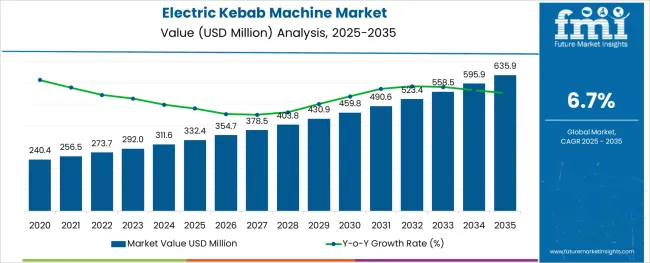
The electric kebab machine market is advancing steadily as rising demand for convenient, efficient, and hygienic food preparation solutions aligns with evolving culinary trends. Growing emphasis on energy-efficient appliances and the expanding footprint of quick service restaurants and catering businesses have contributed to the market’s momentum.
Innovations in compact and durable designs, alongside increasing preference for electric over gas-powered units due to regulatory and safety considerations, have enhanced adoption rates. Future growth is expected to benefit from heightened awareness of workplace safety standards, improved aesthetic designs appealing to modern kitchens, and the integration of easy-to-clean materials.
Manufacturers are also focusing on customization and multi-functionality to cater to diverse buyer needs, paving the way for further market expansion and deeper penetration in emerging markets.
The market is segmented by Voltage, Buyer Type, and Sales Channel and region. By Voltage, the market is divided into 220V, 6V, 110V, 380V, and Other. In terms of Buyer Type, the market is classified into Commercial Buyers and Household Buyers. Based on Sales Channel, the market is segmented into Food Equipment Specialty Retailers, Brand Franchised Stores, Modern Trade, eCommerce Platforms, and Others. Regionally, the market is classified into North America, Latin America, Western Europe, Eastern Europe, Balkan & Baltic Countries, Russia & Belarus, Central Asia, East Asia, South Asia & Pacific, and the Middle East & Africa.
The market is segmented by Voltage, Buyer Type, and Sales Channel and region. By Voltage, the market is divided into 220V, 6V, 110V, 380V, and Other. In terms of Buyer Type, the market is classified into Commercial Buyers and Household Buyers. Based on Sales Channel, the market is segmented into Food Equipment Specialty Retailers, Brand Franchised Stores, Modern Trade, eCommerce Platforms, and Others. Regionally, the market is classified into North America, Latin America, Western Europe, Eastern Europe, Balkan & Baltic Countries, Russia & Belarus, Central Asia, East Asia, South Asia & Pacific, and the Middle East & Africa.
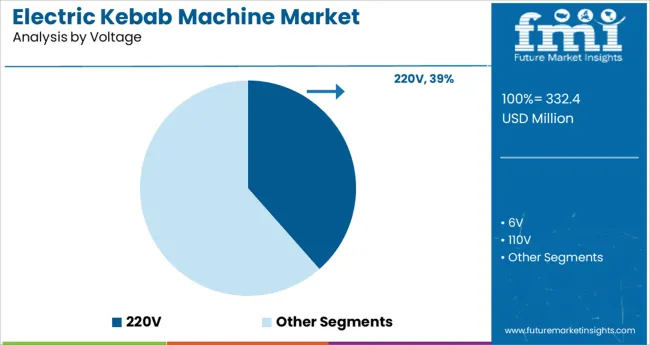
When segmented by voltage, the 220V subsegment is estimated to hold 38.5% of the overall market revenue in 2025, positioning it as the leading voltage configuration. This dominance is attributed to its compatibility with standard commercial and residential electrical systems in many regions, ensuring ease of installation and operation.
The 220V machines are preferred for their ability to deliver sufficient power output while maintaining energy efficiency, making them suitable for continuous use in busy kitchen environments. Their moderate power requirement strikes a balance between performance and safety, which has reinforced trust among buyers.
Additionally, the availability of 220V machines across a wide range of capacities and designs has supported their adoption by businesses seeking reliability and cost-effectiveness.
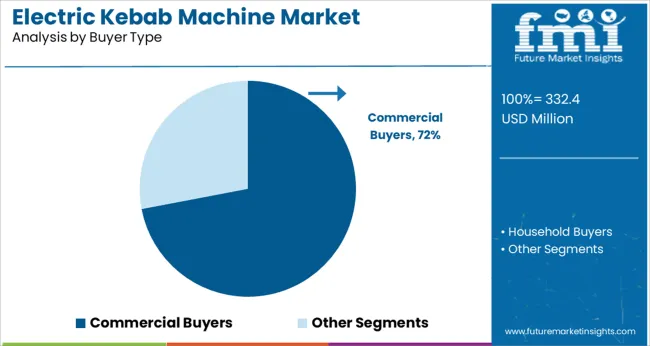
Segmented by buyer type, the commercial buyers segment is projected to account for 72.0% of market revenue in 2025, establishing itself as the dominant buyer group. This leadership has been driven by the rising number of restaurants, hotels, catering services, and food trucks prioritizing productivity and hygiene in food preparation.
Commercial buyers have shown greater willingness to invest in durable and high-performance machines capable of meeting high-volume demand efficiently. Their purchasing decisions are influenced by factors such as operational longevity, ease of maintenance, and compliance with food safety standards, which electric kebab machines effectively address.
The ability to standardize cooking quality and reduce manual labor has further motivated adoption in the commercial segment, reinforcing its prominent position in the market.
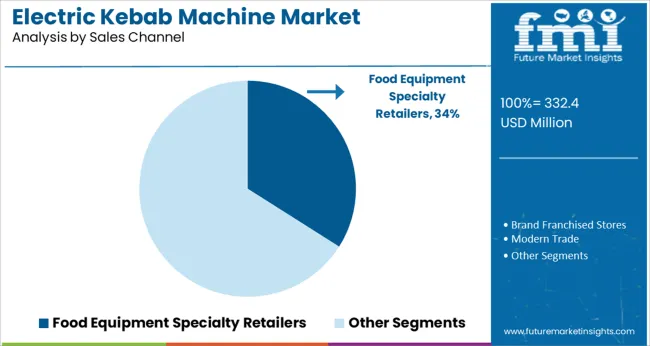
When segmented by sales channel, food equipment specialty retailers are expected to capture 34.0% of the market revenue in 2025, securing their status as the preferred distribution channel. This preference is supported by their ability to offer expert guidance, after-sales support, and a curated selection of machines tailored to professional needs.
Buyers have increasingly relied on specialty retailers for their assurance of quality, access to branded products, and availability of customization options. The personalized service and installation assistance provided by these retailers have also contributed to higher buyer confidence and satisfaction.
Furthermore, their established relationships with manufacturers and understanding of buyer requirements have enabled them to remain a crucial link in the supply chain, sustaining their leading share in the sales landscape.
The electrical kebab machine market analysis report released by FMI tracks the previous performance of the major players to give a wholesome view of the market players. As per the records, the growth rate of the overall electric kebab market during the period covering the year 2024 to 2025 was about merely 5.3%.
Product sales have been boosted by the growing popularity of cookouts and barbeques among the youth of today. Moreover, the growing trend and use of smart kitchen appliances have created a general tendency of customers to shift away from traditional or mechanical kitchen utensils and equipment.
Grilled or roasted food items are frequently thought to be healthier since it is prepared naturally with little spices and other seasonings, which has created a huge demand for electric kebab machine for home. Furthermore, the ease and interior usability of these items provide the electric kebab machine with a competitive advantage in the marketplace over traditional kebab machines.
Other prominent factors for the tremendous rise in demand for electric kebab machine are people's transforming lifestyles with cross-cultural influence and the proliferation of electronic media platforms. Along with this, the increased wages and benefits, growing expendable income, and preference for nutritious grilled foodstuff and meals have increased the sales of electric kebab machine throughout the world.
These product type also uses several forms of smoke to improve the flavor of meat and other foodstuffs without the inconvenience of burning. Moreover, the increased acceptance of these grills in major restaurants and hotels in the business sector is regarded to be the key factor for driving the segment at a faster rate than any other segment of the electric kebab machine market.
The commercial buyer's segment recorded sales of more than 50% and is predicted to expand significantly due to increased product use in restaurants, hotels, and public events. On the other hand, the household application segment of the global kebab machine market is expected to overtake the former segment by growing at an average CAGR of 6.9% from 2025 to 2035.
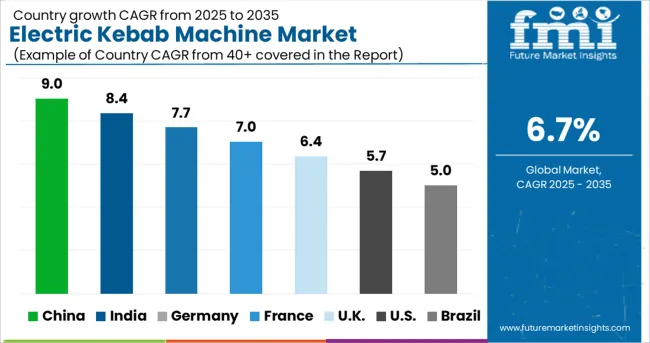
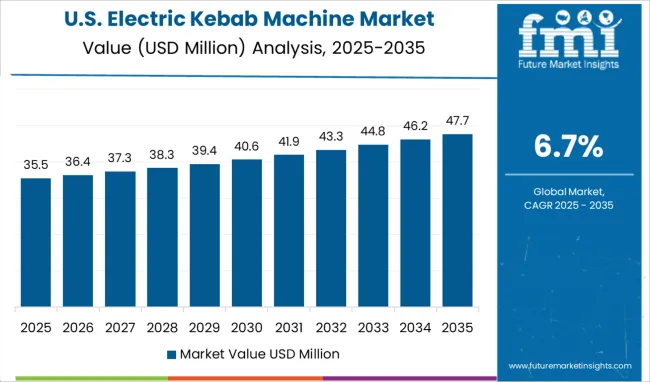
In accordance with the electric kebab machine market survey report, the United States had the greatest market share of 33% in overall revenue generation. The USA Electric kebab machine market is projected to retain its dominance by growing at a healthy CAGR of 7.2% and attaining a sales volume of nearly USD 635.90 Million in the final year of this projected timeline.
Owing to the greater prevalence of at-home and outdoor cooking facilities, the Region had the largest number of electric Doner kebab machine sold in the year 2025. Barbecuing and grilling steaks have become a vital element of consumer behavior in the USA, combined with a desire for taste and flavor variation in dishes. As stated by the Hearth, Patio, and Barbecue Association, 30% of customers in the country use grills or smokers, resulting in increased momentum for the USA electric kebab machine market.
During the years 2025 to 2035, the United Kingdom's electric kebab machine industry is expected to rise rapidly with the highest CAGR of 8.4% of any other country. This expansion from the previous growth rate of 5.3% during the years 2020 to 2025 can be ascribed to millennials' and youths' increased interest in recreational culinary activities.
Similar emerging trends in the electric kebab machine market can be traced in other European nations resulting in an outgrowth of regional players in recent years. Additionally, the German, France, and Italy electric kebab machine market income is getting highly driven by the tourists' predilection for grilled vegetables and meats in their diet.
As per the records of the electric kebab machine market statistics report, the product demand in South Korea is expected to grow at a rate of 5.2% and is headed to contribute around USD 635.9 Million by the year 2035. South Korean electric kebab machine market witnessed rapid development as a result of rising street food consumption and investment in barbeque items in important regions such as China and South Korea.
The ubiquity of sandwiches, hotdogs, and French toast on outdoor barbecues, as well as the rising desire for items other than burgers and fries, are opening the door for the regional electric kebab machine market. Electric kebab machine manufacturers in South Korea are heavily putting money into new product designs with sophisticated technical features in order to give consumers the greatest convenience. For example, Char-Broil debuted the SmartChef app, which assists in managing the device thermostat, grilling time, and burner temperature.
As per the electric kebab machine market report, the overall growth rate of the target market in Japan is estimated to be around 6.9% and is projected to reach almost USD 35 Million by the end of the year 2035.
The traditional inclination for healthy foods, coupled with changing lifestyles and the desire for handmade grilled foods, are the primary reasons for the continued expansion of the electric kebab machine industry in Japan. Though the growth rate in terms of sales of electric kebab machine in Japan is less than that 8.4% in China, the strengthening of the export sector has made it a lucrative region for global and regional market players.
The automatic kebab grill with no smoking difficulties has exploded the regional markets for the product's attraction for domestic use. The bulk of customers is millennials who want to cook in their backyards. Furthermore, due to the impact of TV culinary shows such as BBQ Pitmasters by Grilling with Rich's, this group is more motivated to engage in cooking experiments and adventures.
To liven up their respective product portfolio, the major electric kebab machine companies and competitors are boosting their expenditure on innovation, technological advancements, as well as flexibility. For example, in March 2020, Kenyon International, Inc. introduced its new IntelliKEN Touch product line, including an electric kebab machine for sale, which has a touchscreen control system and a built-in cooking timer for further precision.
Likewise, Spectrum Brands, Inc. introduced the George Foreman Grills Five Serving Grill & Broil with five Teflon plates in September 2020. The device has space for countertop broiling capabilities, allowing customers to barbecue, bake, and melt all in one single appliance.
Even existing electric kebab machine market players are introducing new product lines for commercial as well as household buyers in the market that incorporate cutting-edge technology and creativity. Weber, for example, introduced an infinite ignition switch with a guaranteed start a few years back also providing a 10-year warranty on the item.
Another electric kebab machine market key player named Char-Broil introduced two smart smokers by the name of the Simple smoker, which employs an incorporated meat probe smoking method, and the Digital Electric smoker, which could be used for up to 6.5 hours without interruption.
Releasing the product with other necessary accessories and equipment such as a kebab cutting machine or kebab slicer machine is a major strategy adopted by the new market players. Furthermore, manufacturers provide a variety of modalities, such as countertop design for permanent kitchen placement, in order to capitalize on the dominance of interior applications in the home sector.
For example, in March 2020, Weber-Stephen Products LLC introduced the Q1400 electric shawarma kebab grill machine which is a multipurpose product with connected USB ports and wireless access through a mobile application and is suitable for grilling, baking, convection, and roasting.
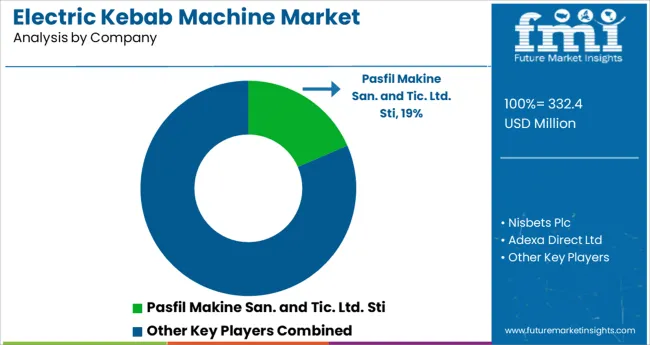
Mainstream brands such as Weber-Stephen Products LLC and The Coleman Company, Inc. have captured the lion's share of the market, with around 30% and 26% market shares, respectively. Furthermore, in order to match the predicted demand, the electric kebab machine market key players are customizing the products as per the customer's requirements and desires.
The electric kebab machine market's major players are increasingly emphasizing on innovation process as a response to new and better product demand, which has helped them achieve a larger worldwide market share. In light of the growing desire for healthier eating habits and smart options to cook food in the majority of countries, fresh product introductions help keep customers' perception of the brand intact.
The global electric kebab machine market is estimated to be valued at USD 332.4 million in 2025.
It is projected to reach USD 635.9 million by 2035.
The market is expected to grow at a 6.7% CAGR between 2025 and 2035.
The key product types are 220v, 6v, 110v, 380v and other.
commercial buyers segment is expected to dominate with a 72.0% industry share in 2025.






Full Research Suite comprises of:
Market outlook & trends analysis
Interviews & case studies
Strategic recommendations
Vendor profiles & capabilities analysis
5-year forecasts
8 regions and 60+ country-level data splits
Market segment data splits
12 months of continuous data updates
DELIVERED AS:
PDF EXCEL ONLINE
Electrical Label Market Size and Share Forecast Outlook 2025 to 2035
Electric Round Sprinklers Market Size and Share Forecast Outlook 2025 to 2035
Electric Cloth Cutting Scissors Market Size and Share Forecast Outlook 2025 to 2035
Electrical Insulation Materials Market Size and Share Forecast Outlook 2025 to 2035
Electric Aircraft Sensors Market Size and Share Forecast Outlook 2025 to 2035
Electric Traction Motor Market Forecast Outlook 2025 to 2035
Electric Vehicle Sensor Market Forecast and Outlook 2025 to 2035
Electric Vehicle Motor Market Forecast and Outlook 2025 to 2035
Electric Off-Road ATVs & UTVs Market Size and Share Forecast Outlook 2025 to 2035
Electric Blind Rivet Gun Market Size and Share Forecast Outlook 2025 to 2035
Electric Fireplace Market Size and Share Forecast Outlook 2025 to 2035
Electric Glider Market Size and Share Forecast Outlook 2025 to 2035
Electric Vehicle Battery Conditioners Market Size and Share Forecast Outlook 2025 to 2035
Electric Power Steering Motors Market Size and Share Forecast Outlook 2025 to 2035
Electric Motor Market Size and Share Forecast Outlook 2025 to 2035
Electric Gripper Market Size and Share Forecast Outlook 2025 to 2035
Electric Boat Market Size and Share Forecast Outlook 2025 to 2035
Electric Bicycle Market Size and Share Forecast Outlook 2025 to 2035
Electric Vehicle Transmission Market Size and Share Forecast Outlook 2025 to 2035
Electrical Enclosure Market Size and Share Forecast Outlook 2025 to 2035

Thank you!
You will receive an email from our Business Development Manager. Please be sure to check your SPAM/JUNK folder too.
Chat With
MaRIA